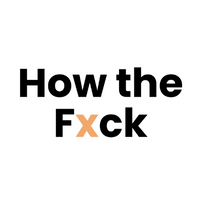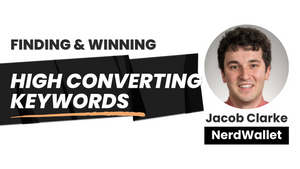Every SEO strategy should be built to win high-converting keywords.
We call the most important ones "money keywords". These target searchers who are currently:
- Researching what to buy
- Looking to buy right now
- Looking explicitly for you
This is where the real money is in SEO, which means these keywords are often highly competitive to rank for.
However, direct purchases and other bottom-of-funnel actions are just one type of conversion possible.
In reality, every single keyword has the potential to convert a reader into:
- A newsletter subscriber
- A social media follower
- A community member
- A loyal fan
Your job is to craft an offer so compelling and so aligned with your reader's interests, that they can't help but take the next step.
Then another. Then another.
And before you know it, they know your brand and what you offer, and, when the time comes, they'll choose to buy from you.
In this week's guide, expect a deep dive into:
- The highest-converting keyword groups
- How to find high-converting keywords for your niche
- How to convert traffic (with compelling offers and on-page design)
Let’s dive in.
What Are High Converting Keywords?
Simply put, there isn’t just one way for a user to convert on a website.
In fact, there are dozens of types of conversions a page could aim for, depending on the goals of the website:
- Clicking on an affiliate link
- Scheduling an appointment
- Signing up for a newsletter
- Downloading an eBook
- Taking an email course
- Contacting a customer service representative
- Signing up for a free demo/free trial
The highest conversion rates come from matching the conversion goal to the buyer stage of the keyword.
Here's an example of the path a friend of mine took to conversion on the keyword "effective ways to lose weight".
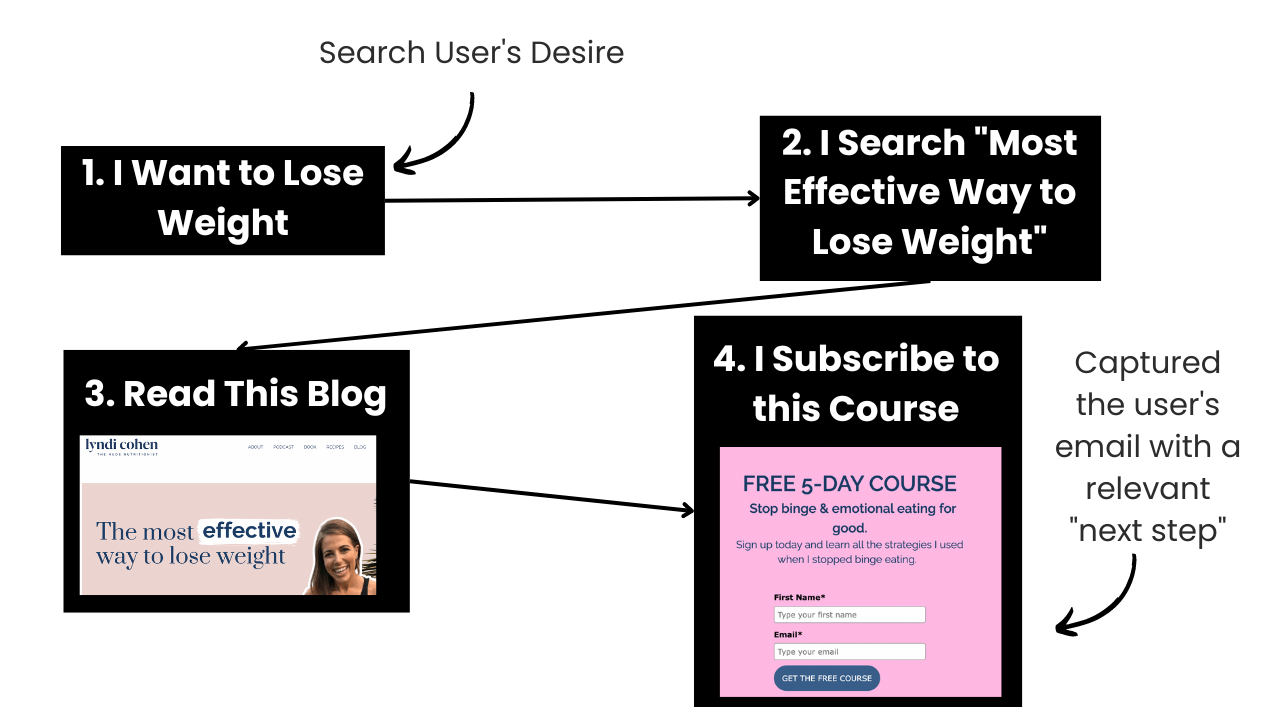
See how well targeted the "next step" is to the keyword?
Let's imagine you work for Hubspot, someone reading an article called “What is marketing?” is unlikely to respond well to your call-to-action (CTA) to “book a demo of our CRM software!” They aren’t that far along in the buying cycle yet.
However, since they are a beginner-level reader, they are likely to respond well to an email course or eBook titled “How to Create a Marketing Strategy”.
Achieving a high conversion rate is ALL about matching your offer to the reader's current expertise and pain points.
Check out this clip from Jacob Clarke from NerdWallet (and a bit from me) on why it's important to declare your primary conversion goal first:
High-Converting Keyword Examples - Commercial Intent
As I’ve pointed out twice already, every keyword can be high converting if the offer is right.
But if you’re looking for direct product sales, signups or meetings, you should start by identifying keywords with commercial intent.
Here are some high-converting keyword templates with commercial intent:
- [X product category] software - Example: fleet management software, web design software, budget tracking software, etc.
- Best [X product category] software - Examples: best marketing software, best CRM software
- [X product name] vs. [ Y product name] - Examples: WordPress vs Wix, Figma vs Adobe, Jira vs Trello, etc.
- [X product name] alternatives or [X product name] competitors - Examples: Photoshop alternatives, Canva competitors, WordPress alternatives, Ahrefs competitors, etc.
- [X product name] reviews - Examples: Asana reviews, toggle reviews, Grammarly reviews, etc.
- [persona] + [X product category] - Examples: content marketing software, product marketing software, sales email software
See even more of these bottom-of-funnel keywords in our article here.
How to Find Commercial Intent Keywords to Target
Now that you have an idea of what constitutes a high-converting keyword, here’s how to find the ones relevant to your own website and niche:
- Identify keywords that your competitors’ strategies are targeting.
- Research keywords with your competitors’ names in them.
- Search for ‘category’ keywords.
- Search for ‘category + persona’ keywords.
1. Look at competitors (and sort by CPC)
A tried and true method for keyword research (and uncovering high-converting keywords, especially commercial ones) is to look at what your competitors are targeting.
Copy and paste your competitors’ domains in your keyword research tool of choice and filter for keywords that have a high CPC (cost-per-click) where the site is ranking in the top 3.
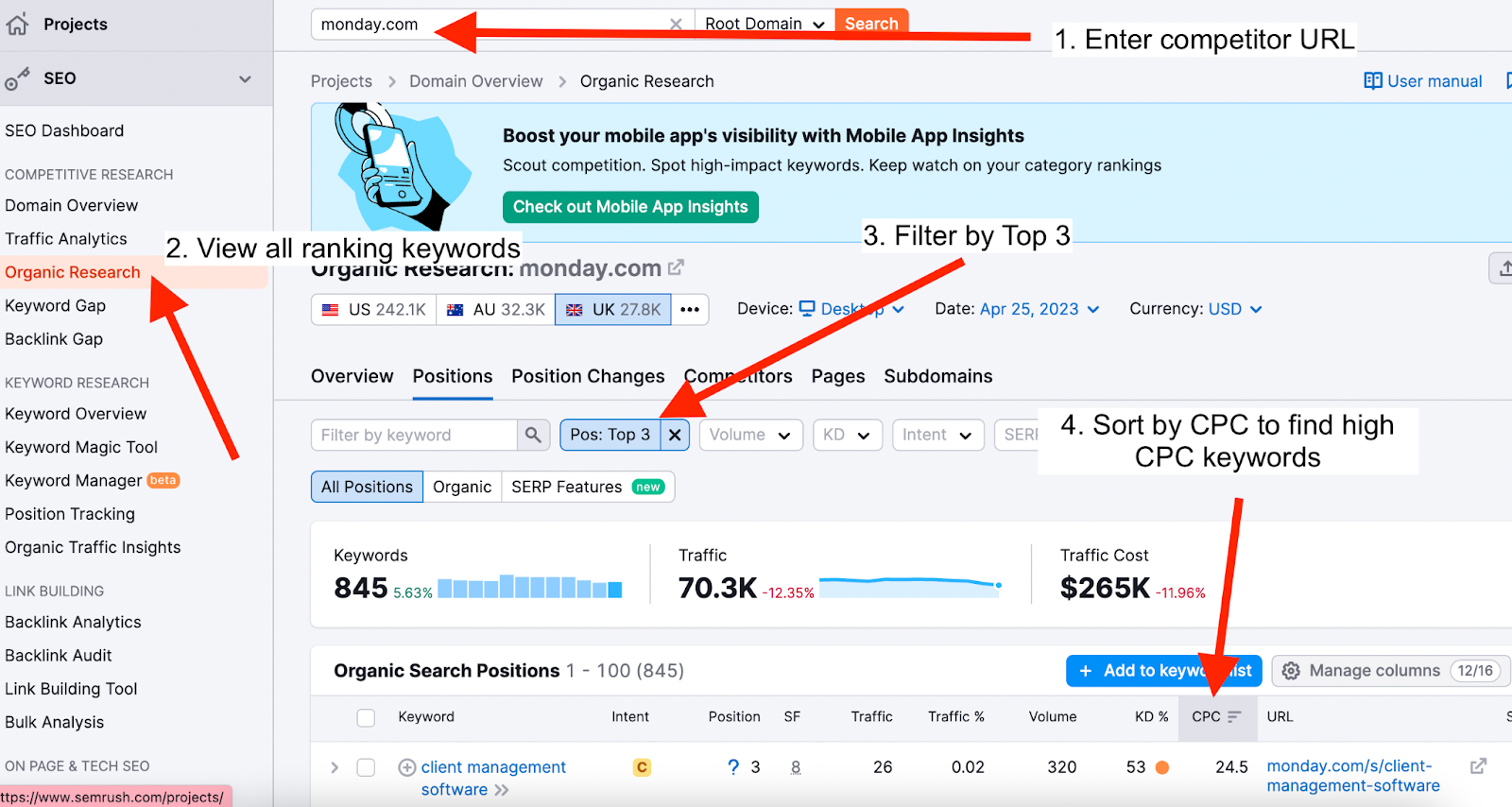
A high CPC typically indicates that a keyword has high commercial intent, because businesses will invest a lot of money to advertise for it.
Here is an example of high-CPC keywords targeted by the project management tool Monday.com:
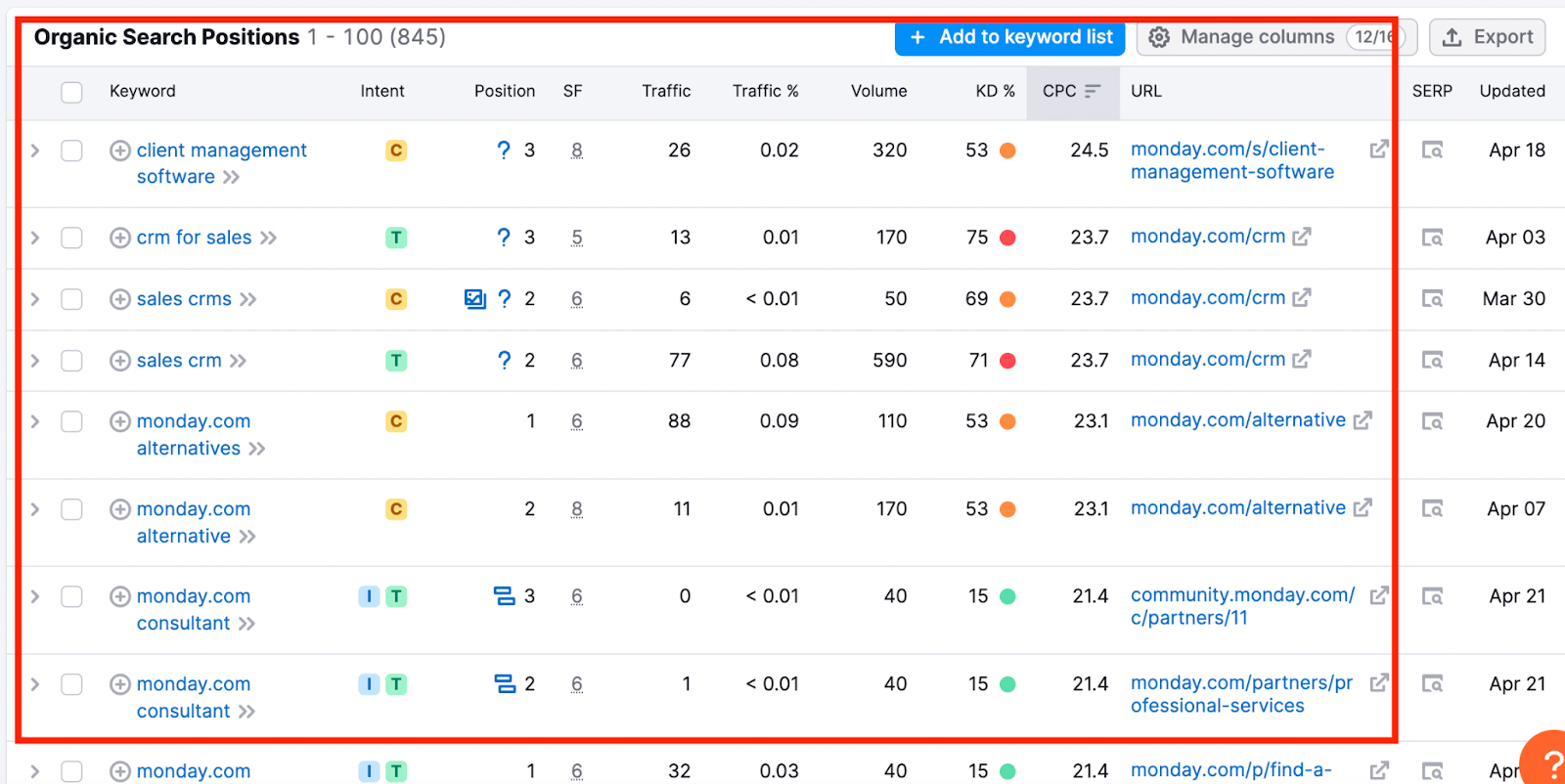
The top one “client management software” fits the pattern “X software category” we mentioned above. You’ll likely find many of these.
The keyword “sales CRM” fits the pattern “persona + software category”.
2. Find keywords with competitor names in them
[Product] vs [product] and [product] alternatives keywords require you to uncover keywords with the names of your competitors in them.
Most of these keywords will be pretty straightforward, such as the two mentioned just now, but you could also come across some long-tail gems, such as:
- alternatives to Crucible that integrate with Jira
- free alternatives to Canva with Google login
To find these more easily, use these modifiers alongside your competitor’s names in a tool like Semrush:
- Name + Alternative
- Name + Competitors
- Name + vs
![Screenshot from Semrush providing ideas on 'monday.com vs [alternative tool]' keywords.](https://seo.thefxck.com/content/images/2023/05/data-src-image-a98074ec-c957-4a20-a281-bd4fc8c9445f.png)
3. Search by category
Type in your product category into a keyword research tool and see what kinds of related or matching terms come up.
Here are the results for the broad high-converting commercial keyword marketing software:
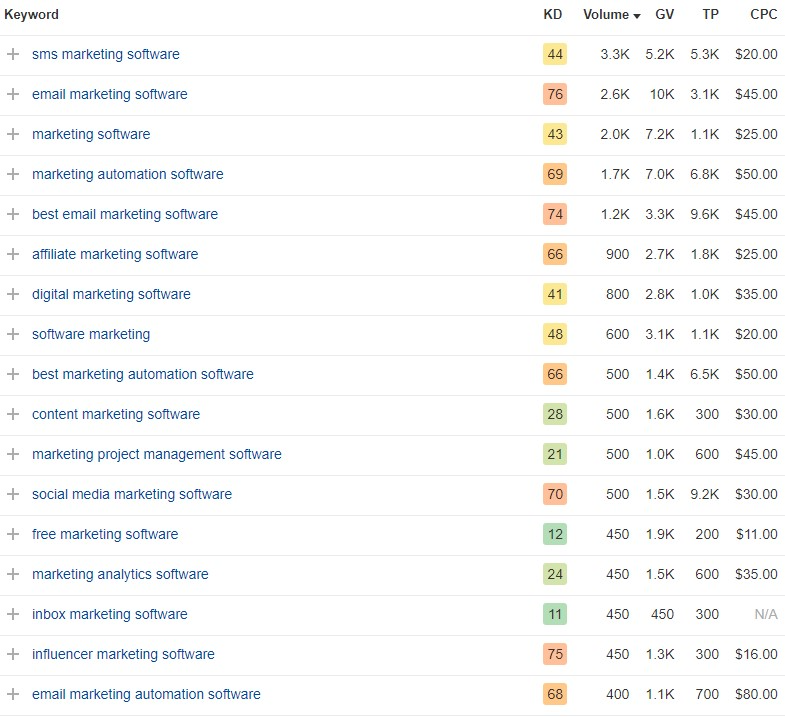
Use these modifiers to find opportunities like these:
- [Your category] + software
- [Your category] + consultant
- [Your category] + services
- [Your category] + tool
- [Your category] + platform
- [Your category] + solutions
4. Search by category + persona
Who is your product for? What audience segments are you targeting with your marketing?
Typing in category + persona into a keyword research tool gives plenty of high-converting keywords to choose from.
Here are the results for the (partial) keyword marketing software for:
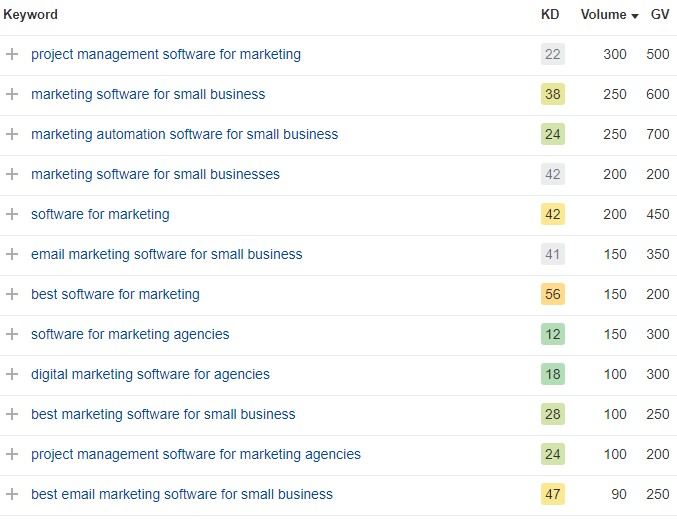
Use these modifiers to find opportunities like these:
- [Your category] + for
- [Your target audience] + software
- [Your target audience] + templates
Which Keywords Have a High Potential to Convert?
Although every keyword has conversion potential, there are some keywords where conversion is really obvious.
Goal: Build a newsletter list
For example, if I wanted to build my newsletter list, I would target keywords where a download is expected by the reader:
- SEO strategy template
- SEO case study template
- SEO brief template
- Best SEO newsletters
I know if I can get these ranking at the top of Google, then people have a need I can fulfill with a downloadable.
How to Actually Convert Readers (Build a High-Converting Page)
It’s one thing to know which high-converting keyword you’re targeting. It’s another matter entirely to actually convert the reader.
Here’s how to design a page that converts, based on the type of keyword targeted.
Converting Top-of-Funnel Readers
To convert the reader of an educational or inspirational-focused keyword, first ask yourself two questions:
- After reading this article, what is the natural next step for the reader?
- What would best help them reach that next step?
If you can offer something that takes them there, you’ll likely convert them.
Example:
You’re reading an article about high-converting keywords right now. Your natural next step might be to go find high-converting keywords and write blog posts.
If I offered you a best practice blog post template that would help you write the article “best X software”, you’d be highly likely to download it. It would save you time and improve outcomes.
(In my latest SEO case study, I shared a guide on creating "logical next steps" on pages 23 and 24.)
Here are some other ways to convert top-of-funnel readers:
- Create a sidebar that advertises your product - That way, the users can see it but it doesn’t disrupt their reading experience.
- Create an in-content CTA - Move that sidebar advertisement into the content itself and break the reader out of their flow.
- Create a downloadable template (if applicable) - A useful resource with your company’s name and branding that will help the user achieve their goal will go a long way in keeping your brand top of mind when they start looking for a product.
- Create a 5-step email course (if applicable) - An email course that teaches the user how to solve their problem is a win-win for both sides - they walk away with new knowledge, and you get a new email lead!
- Create a newsletter CTA (if applicable) - Similarly to number 4, a newsletter CTA is a great way to collect email addresses of those interested in your content and potentially your product.
Converting Middle-of-Funnel Readers
Users in the middle of their buying journey require you to empathize more with them. Demonstrate that you understand their problems, and that you have felt their pain.
To increase conversions on a mid-funnel page, you can:
- Insert a video of your product solving the problem the reader has.
- Insert quotes from your actual customers describing their struggles and pain points that are relatable to the reader.
- Weave an inspirational customer story through the text. This should be a journey story in which the customer started off in the same place where the reader is now, but in the end they overcame their challenges (with the help of your product).
- Quote an internal expert on the subject with invaluable insight for the reader.
Converting Bottom-of-Funnel Readers
Your product (or service) should be front and center in your bottom-of-funnel content (but still in an authentic, not-too-salesy way).
- Embed a demo video of the product.
- Refresh your messaging to target just the right type of person who is on the page.
- Include up-to-date screenshots of the product.
Important: Avoid ‘By The Way CTAs’
No matter what keyword type you’re targeting, there is one crucial mistake you must avoid: what Jacob dubbed ‘By the Way CTAs’ (yes, it rhymes, it’s amazing).
A ‘By the Way CTA’ is a CTA at the very end of the article/page inviting the reader to sign up or click for a demo, with no mention of the product anywhere above it or anywhere else in the text.
“The percentage of readers who go straight down your page and arrive at the bottom - it’s a pretty small percentage at the end of the day. You want to be intentional about weaving in, first, just how your product or service solves the problem, but then also conversion opportunities.” - Jacob Clarke
Whatever you do, don’t save the conversion opportunity for the very last sentence in the article.
Learn How These Companies Use High-Converting Keywords
These SEO case studies are a great place to learn to build a high-value SEO strategy:
- How Monday.com Wrote 1,000 SEO Articles in 12 Months [A great framework in there for choosing valuable keywords]
- How Retro Dodo Grew to 1 Million Clicks & $50K Monthly Revenue [If you're in the affiliate or niche site space, RetroDodo's entire site almost focuses on high-converting keywords]
- How Maze Built an SEO Revenue Engine. [Lots of tips on converting visitors here]
